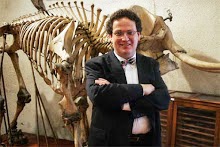 |
| ROBOT(e) telemicroscopy unit during final testing in our laboratory before shipment to Europe. PHOTO: Erik Holsinger, Arizona State University). |
One Small Step for Engineering, One Giant Leap for Cybertaxonomy
Tim Gostony, the wizard behind the software that operates ROBOT(e), will be in London and Paris next week making final adjustments to the instruments that I sat up there a couple of months ago, and the third unit was set up at the Smithsonian just a couple of weeks ago. Following Tim's hardware and software upgrades we will do final testing of the units and then make plans for an official launch of the network.
ROBOT(e) is an acronym for Remotely Operable Benchmarking Of Types (Entomology), our first generation of functional remotely operable digital microscopes. The idea is simple. At a pre-arranged date and hour a curator places a type or rare specimen in the pin holder. That's it until the specimen needs to be returned to the collection. The remote user logs in and remotely turns on the electrical supply for the camera, lift, five microstep motors, and lamps. The user has total control and can manipulate the specimen on multiple axes: spinning 360 degrees, tilting (to see ventral surface) 180 degrees, moving on X or Y axis, and raising or lowering camera on Z axis. The user chooses between auto and manual focus and with the click of a button can take a high resolution image of the specimen that can be saved both to a local hard disk and backup up to the host museum's hard disk.
Access to type specimens continues to be a major bottleneck to progress in species exploration and nomenclature. More and more databases rely on Linnaean binominals as unique identifiers for species, yet types are not consulted as often as they should be to keep pace with advancing concepts of species. The idea, of course, is that over time a growing archive of images will obviate the need to handle types either in person or with such a remote instrument... but that is a long way off at this date.
Three instruments may sound like a modest start, but by placing them in the world's three largest insect collections students and researchers around the world have potential access to more than 600,000 insect type specimens representing a very serious percentage of insect species. They also open the possibility for online teaching using the most rare material and virtual repatriation of types, allowing scientists and students in developing nations of origin to access, study, and photograph type and rare specimens collected within their borders.
ROBOT(e) could easily be modified to handle a wide variety of biological, anthropological, and geological museum objects with just a small amount of development money. We received a generous grant from the Virginia M. Ullman Foundation that fully funded the software development and construction of the prototype. The final three instruments were funded by the IISE and with generous in-kind donation of engineering expertise, time, and parts by Visionary Digital, Inc. Without this amazingly generous donation the final instruments could not have been built.
The network and first generation instruments are a proof of concept and we are already working on ideas for enhancements such as enhanced light control to create shadows, automated image montages, a measuring function, and 3D imaging, just to name a few. We are hoping to next find an investor or investors that make these add on features possible and that allow us to take the next step into cybertaxonomy.
We have been working on a concept for a truly robotic imaging system for types. Without special knowledge of the taxon, a curator or technician places a type in the instrument and presses a button. Fifty images are automatically taken and stitched together to form a 3D, zoom-able, rotatable "e-type." This high throughput instrument is necessary to deal with the back log of insect type specimens estimated at 2.5 to 3 million in number. We calculate that fewer than two dozen such instruments could generate 1 million e-types in five years... and faster, of course, with more units. Several such units would be needed in the large museums and others would be nomads going museum to museum. When the backlog is caught up, the instruments would be permanently housed in regional e-typification centers where individual taxonomists and smaller institutions could send types to be digitized.
A discussion of how ROBOT(e) fits into a wider strategy to deal with insect type specimens (that are, incidentally, half of all types) can be found in our recent paper:
Wheeler, Q.D. et al. 2012: Mapping the biosphere: exploring species to understand the origin, organization and sustainability of biodiversity. Systematics and biodiversity, 10(1): 1-20.
doi: 10.1080/14772000.2012.665095
A free PDF can be downloaded from:
http://www.tandfonline.com/doi/abs/10.1080/14772000.2012.665095
Botanists have been leading the charge and have a great deal of the digitization of herbarium type specimens completed. Once the insects are done, the herbaria plus hundreds of other efforts around the world would bring us closer to the vision of having all types digitized than could have been imagined prior to cybertaxonomic instrumentation.




